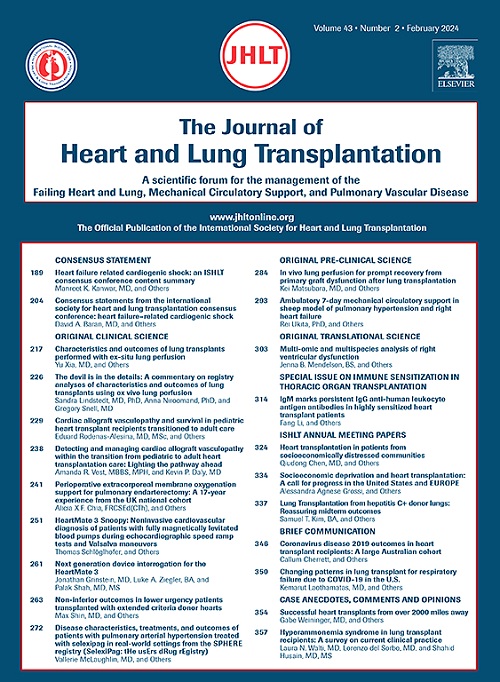Long short-term memory algorithm for personalized tacrolimus dosing: A simple and effective time series forecasting approach post-lung transplantation
IF 6
1区 医学
Q1 CARDIAC & CARDIOVASCULAR SYSTEMS
引用次数: 0
Abstract
Background
Management of tacrolimus trough levels (TTLs) influences morbidity and mortality after lung transplantation. Several studies have explored pharmacokinetic and artificial intelligence models to monitor tacrolimus levels. However, many models depend on a wide range of variables, some of which, like genetic polymorphisms, are not commonly tested for in regular clinical practice. This study aimed to verify the efficacy of a novel approach simply utilizing time series data of tacrolimus dosing, with the objective of accurately predicting trough levels in a variety of clinical settings.
Methods
Data encompassing 36 clinical variables for each patient were gathered, and a multivariate long short-term memory algorithm was applied to forecast subsequent TTLs based on the selected clinical variables. The tool was developed using a dataset of 87,112 data points from 117 patients, and its efficacy was confirmed using 6 additional cases.
Results
Shapley additive explanations revealed a significant correlation between trough levels and prior dose-concentration data. By using simple trend learning of dose, administration route, and previous trough levels of tacrolimus, we could predict values within 30% of the actual values for 88.5% of time points, which facilitated the creation of a tool for simulating TTLs in response to dosage adjustments. The tool exhibited the potential for rectifying clinical misjudgments in a simulation cohort.
Conclusions
Utilizing our time series forecasting tool, precise prediction of trough levels is attainable independently of other clinical variables through the analysis of historical tacrolimus dose-concentration trends alone.
个性化他克莫司剂量的长短期记忆算法:肺移植术后简单有效的时间序列预测方法。
背景:他克莫司谷值的管理影响着肺移植术后的发病率和死亡率。有几项研究探讨了监测他克莫司水平的药代动力学和人工智能模型。然而,许多模型依赖于广泛的变量,其中一些变量,如基因多态性,在常规临床实践中并不常见。本研究旨在验证一种新方法的有效性,该方法只需利用他克莫司剂量的时间序列数据,目的是在各种临床环境中准确预测谷值水平:方法: 收集了每位患者 36 个临床变量的数据,并应用多变量长短期记忆算法,根据所选临床变量预测随后的他克莫司谷值水平。该工具的开发使用了来自 117 名患者的 87 112 个数据点的数据集,并使用另外六个病例证实了其有效性:结果:Shapley Additive exPlanations 发现,低谷水平与之前的剂量浓度数据之间存在显著相关性。通过对剂量、给药途径和先前的他克莫司谷值进行简单的趋势学习,我们可以预测 88.5% 时间点的值在实际值的 30% 以内,这有助于创建一个工具来模拟他克莫司谷值对剂量调整的反应。该工具展示了在模拟队列中纠正临床错误判断的潜力:结论:利用我们的时间序列预测工具,仅通过分析他克莫司剂量浓度的历史趋势,就能独立于其他临床变量精确预测谷值水平。
本文章由计算机程序翻译,如有差异,请以英文原文为准。
求助全文
约1分钟内获得全文
求助全文
来源期刊
CiteScore
10.10
自引率
6.70%
发文量
1667
审稿时长
69 days
期刊介绍:
The Journal of Heart and Lung Transplantation, the official publication of the International Society for Heart and Lung Transplantation, brings readers essential scholarly and timely information in the field of cardio-pulmonary transplantation, mechanical and biological support of the failing heart, advanced lung disease (including pulmonary vascular disease) and cell replacement therapy. Importantly, the journal also serves as a medium of communication of pre-clinical sciences in all these rapidly expanding areas.

 求助内容:
求助内容: 应助结果提醒方式:
应助结果提醒方式:


